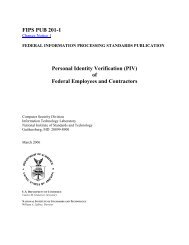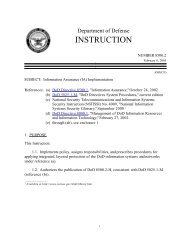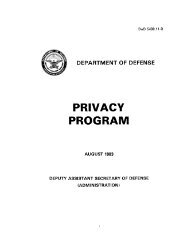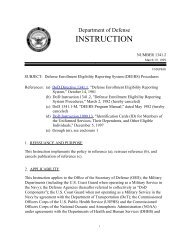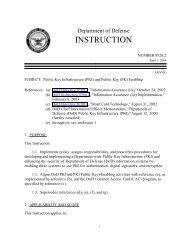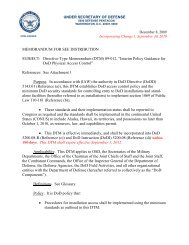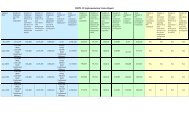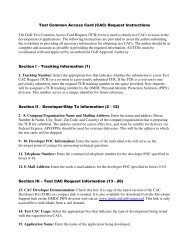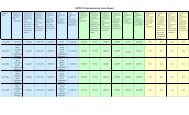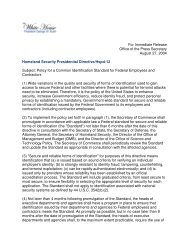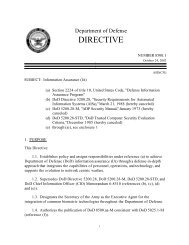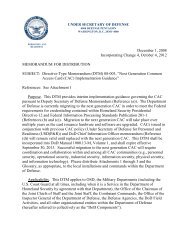Download Here - Common Access Card (CAC)
Download Here - Common Access Card (CAC)
Download Here - Common Access Card (CAC)
Create successful ePaper yourself
Turn your PDF publications into a flip-book with our unique Google optimized e-Paper software.
stored in the registry and maintainable via group policy for central<br />
administration.<br />
4.11.1.2 Middleware shall have the ability to enable or disable any and all<br />
configurable settings for the end user at time of installation.<br />
4.11.1.3 Middleware configuration settings shall be set and configured in<br />
accordance with Appendix A, Figures 1, 2, and 3.<br />
4.11.1.4 Middleware shall provide an option to automatically register (or make<br />
available for use) all user certificates stored on the <strong>CAC</strong> for MS Internet<br />
Explorer based environments.<br />
4.11.1.5 Middleware shall provide an option to automatically remove <strong>CAC</strong><br />
certificates from the workstation on card removal events.<br />
4.12 PIN Management<br />
4.12.1 PIN Services<br />
4.12.1.1 Middleware shall provide a single PIN service, which will have the ability to<br />
handle PIN management for MS-CAPI, MS-CAPI Next Generation (CNG), and<br />
PKCS11 interfaces. For example, if a user enters a PIN for use with MS-CAPI,<br />
and then uses the PKCS11 interface within the specified PIN timeout period,<br />
the user should not have to re-enter the PIN since the same PIN service would<br />
handle the PIN requirements for both PKCS11 and MS-CAPI modules.<br />
4.12.1.2 Middleware shall have the ability to set the amount of inactivity time, which<br />
should elapse before the card requires a PIN entry. Inactivity time shall be<br />
defined as the amount of time elapsed since the last time a PIN-protected area<br />
on the <strong>CAC</strong> was accessed.<br />
4.12.1.3 Middleware shall have the ability to disable all PIN timeout/caching<br />
features.<br />
4.12.1.4 PIN caching must be accomplished using FIPS 140-2 level 1 or above<br />
approved cryptographic methods to protect the PIN. An outline of the<br />
implementation and the FIPS 140-2 approved methods shall be provided the<br />
vendor.<br />
4.12.1.5 PIN caching methods must ensure that when PINs are cached, they are<br />
visible only to the middleware application, only stored in system memory (e.g.<br />
not on the hard disk drive), and all traces completely removed upon timeout or<br />
card removal.<br />
4.12.1.6 PIN timeout configurations shall be configured and maintained in<br />
accordance with Appendix A, Figure 4.<br />
UNCLASSIFIED 20



